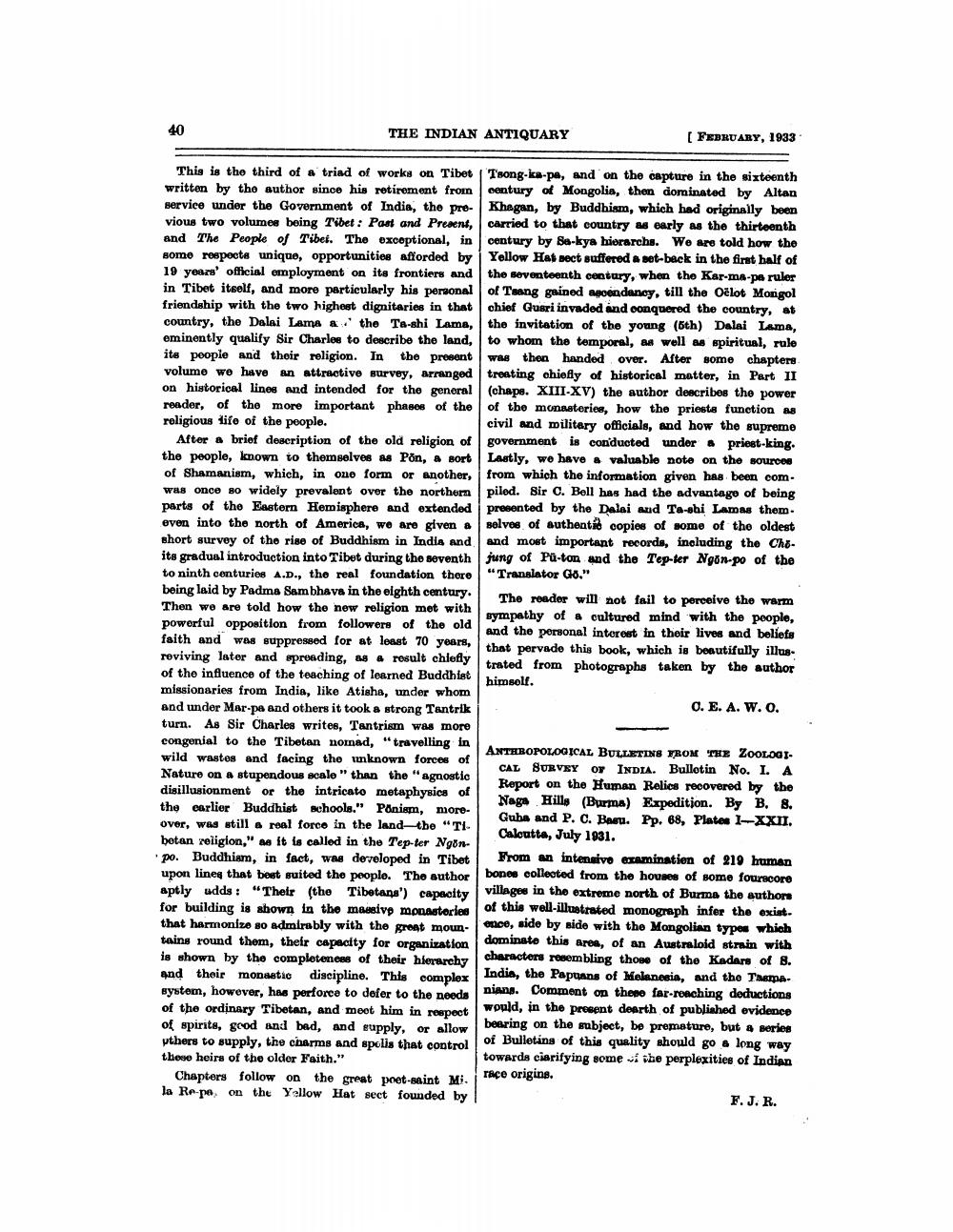________________
40
THE INDIAN ANTIQUARY
FEBRUARY, 1933
This is the third of a triad of works on Tibet Tsong-ka-pa, and on the capture in the sixteenth written by the author since his retirement from century of Mongolia, then dominated by Altan service under the Government of India, the pre- Khagan, by Buddhism, which had originally been vious two volumes being Tibet: Past and Present, carried to that country as early as the thirteenth and The People of Tibet. The exceptional, in century by Ba-kya hiorarcbs. We are told how the somo respects unique, opportunities afforded by Yellow Hat sect suffered a set-back in the first half of 19 years' official employment on its frontiers and the seventeenth century, when the Kar-ma-pa ruler in Tibet itself, and more particularly his personal of Tsang gained apoendancy, till the Oēlot Mongol friendship with the two highest dignitaries in that chief Gusti invaded and conquered the country, at country, the Dalai Lama & the Ta-shi Lama, the invitation of the young (6th) Dalai Lama, eminently qualify Sir Charles to describe the land, to whom the temporal, as well as spiritual, rule its people and their religion. In the present was then handed over. After some chapters volume we have an attractive survey, arranged treating chiefly of historical matter, in Part II on historical lines and intended for the general (chape. XIII-XV) the author describes the power reader, of the more important phases of the of the monasteries, how the priests function as religious life of the people.
civil and military officials, and how the supreme After a brief description of the old religion of government is conducted under & priest-king. the people, known to themselves as Pon, a sort | Lastly, wo have valuable note on the sources of Shamanism, which, in one form or another, from which the information given has been com. was once so widely prevalent over the northern piled. Bir o. Bell has had the advantage of being parts of the Eastern Hemisphere and extended presented by the Dalai aud Ta-sbi Lamas thom. even into the north of America, we are given a selves of authentic copies of some of the oldest short survey of the rise of Buddhism in India and and most important records, including the Chiits gradual introduction into Tibet during the seventh jung of Pu-tom and the Tep-ter Ngon-po of the to ninth centuries A.D., the real foundation there "Translator Go." being laid by Padma Sambhava in the eighth century.
The roader will not fail to perceive the warm Then we are told how the new religion met with
sympathy of a cultured mind with the people, powerful opposition from followers of the old
and the personal interest in their lives and beliefs faith and was suppressed for at least 70 years,
that pervade this book, which is beautifully illus reviving later and spreading, 88 a result chiefly
trated from photographs taken by the author of the influence of the teaching of learned Buddhist
himself. missionaries from India, like Atisha, under whom and under Mar-pa and others it took a strong Tantrik
0. E. A. W.O. turn. As Sir Charles writes, Tantrism was more congenial to the Tibetan nomad, "travelling in
ANTHROPOLOGICAL BULLETINS FROM THE ZOOLOGI. wild wastes and facing the unknown forces of
CAL SURVEY OF INDIA. Bulletin No. 1. A Nature on a stupendous scale" than the "agnostic
Report on the Human Relies recovered by the disillusionment or the intricato metaphysics of
Naga Hills (Burma) Expedition. By B. 8. the earlier Buddhist schools." Pönism, more
Guba and P. C. Basu. Pp. 68, Plates I-XXII. over, was still & real force in the land—the "Ti.
Caloutta, July 1931. botan religion," as it is called in the Tep-ter Ngon'po. Buddhiam, in fact, was developed in Tibet
From an intensive examination of 219 human upon lines that best suited the people. The author bonee collected from the houses of some four core aptly udds: “Their (the Tibetans') capacity village in the extreme north of Burma the author for building is shown in the massive monasteries
of this well-illustrated monograph infer the exist. that harmonize so admirably with the great moun
ence, side by side with the Mongolian types which tains round them, their capacity for organization
dominate this area, of an Australoid strain with is shown by the completeness of their hierarchy characters rosembling those of the Kadare of 8. and their monastio discipline. This complex
India, the Papuans of Melanesia, and the Tama. system, however, has perforce to defer to the needs
nians. Comment on thepo far-reaching deductions of the ordinary Tibetan, and meet him in respect
would, in the present dearth of published ovidence of spirits, good and bad, and supply, or allow
bearing on the subject, be premature, but a series ythers to supply, the charms and spells that control
of Bulletins of this quality should go a long way these heirs of the oldor Faith."
towards ciarifying some vi be perplexities of Indian Chapters follow on the great poet-saint M.
Mirace origine. la Repa, on the Yellow Hat sect founded by
F. J. R.




